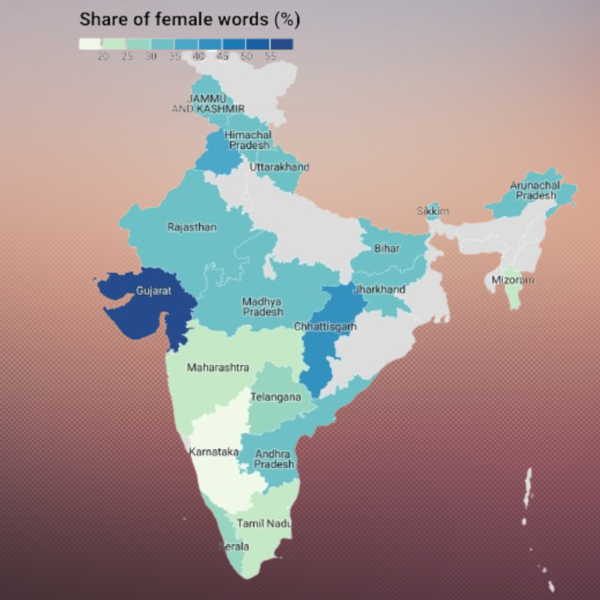The research examined textbooks published in the English language, revealing a disturbing trend in which male-gendered words and stereotypes dominated the narrative. For example, mothers were often associated with domestic chores such as cooking, while professions such as doctors were consistently depicted as male. Despite previous efforts to address these issues, such as a call for reform in 2017 by India’s education minister, the study found little improvement, especially in NCERT textbooks, which have undergone revisions as recently as 2020.
Disparities in Gender Representation: A Comparison of Indian States
One of the most notable aspects of the study was the variation in gender representation across different states. The research found that Gujarat performed the best in terms of female representation, where nearly 60% of gender-related words were female. In contrast, Karnataka fared the worst, where less than 20% of gender-related words represented women. Surprisingly, this imbalance was most pronounced in southern states, including Karnataka and Kerala, which traditionally score high on progressive gender indices such as female literacy and workforce participation.
The table displays the number of textbooks per grade in different states. The data includes textbooks from state boards and NCERT books. NCERT textbooks are selected by state boards in Arunachal Pradesh, Bihar, Himachal Pradesh, Jammu and Kashmir, Jharkhand, Madhya Pradesh, Rajasthan, Sikkim and Uttarakhand. This includes STEM, social sciences, humanities and practical/applied sciences.
This disparity raises questions about the impact of state-level educational policies and the effectiveness of efforts to address gender bias. For example, despite Kerala’s continued efforts to remove gender stereotypes from textbooks, prompted by concerns over domestic abuse, its performance in the study remains dismal.
Meanwhile, MaharashtraIndia’s second most populous state and home to the financial capital Mumbai, is currently undergoing curriculum revision. While criticisms have primarily focused on the lack of representation of socio-economic diversity, the study emphasises that gender representation is also a major concern. Maharashtra’s textbooks rank lowest in terms of female representation, further highlighting the need for comprehensive reform.
In another example, earlier this year, Delhi’s State Council of Educational Research and Training (SCERT) made significant revisions to school textbooks after conducting a comprehensive gender audit of 53 textbooks and syllabi. The audit, led by a committee of experts from NCERT, Delhi University, central education institutions and NGOs, revealed widespread gender biases. These included male-dominated content, portrayal of women in submissive roles and lack of representation for transgender individuals.
Read full report | SCERT audit reveals gender bias in Delhi textbooks, neutral alternatives proposed for 10 terms
Gender bias in relation to social attitudes
Another interesting finding of the study is that there is no clear correlation between the progressive gender norms of a state’s society and the gender bias in its educational content. The research cross-referenced textbook content with a 2022 Pew survey on gender norms, which measured societal attitudes in different states. For example, Mizoram ranked high in terms of progressive gender views, but its textbooks showed only 22% female representation. In contrast, Gujarat, which performed best in terms of textbook representation, scored poorly on progressive gender attitudes.
This inconsistency shows that gender representation in educational materials does not necessarily reflect gender norms prevalent in society. In some states, progressive societal attitudes towards gender have not translated into a more balanced representation of men and women in textbooks. This inconsistency underscores the importance of targeted policy interventions to address gender bias that persists in educational resources, despite widespread societal progress.

This data is drawn from a recent analysis of state textbooks by the Center for Global Development (CGD), using a methodology similar to that used in the cross-country analysis by Crawford, Santis-Miller, and Todd (2024). Note that the map of India is representative, and taken from the original study report.
India’s performance in the World Economic Forum’s Gender Gap Index 2024
The gender bias present in Indian textbooks is part of a broader national context, where gender inequality remains a pervasive issue. According to the World Economic Forum’s Gender Gap Index 2024, India ranks 129th globally in terms of gender equality, making it one of the worst-performing countries. Deeply ingrained stereotypes and underrepresentation of women in educational materials reflect and reinforce broader societal challenges that contribute to this ranking.
Furthermore, the study ranks India, and South Asia more broadly, as the worst region in the English-speaking world when it comes to gender stereotyping in educational content. Compared to textbooks in the U.K., U.S., Australia, and sub-Saharan Africa, Indian textbooks display a greater male bias in terms of language related to achievement and work, while female figures are disproportionately associated with appearance and domestic roles. This male-dominated narrative in textbooks not only limits the aspirations of young girls, but also perpetuates outdated gender roles for all students.
Moving Forward: Improvements Needed
The study highlights the critical need to reform Indian school textbooks to eliminate gender bias. While states like Kerala have taken steps to eliminate stereotypes, more efforts are needed to ensure equal representation for men and women. Beyond the numbers, biased language in textbooks affects students’ perceptions and self-esteem. To make significant progress, national and state policymakers must prioritize eliminating gender bias and updating content. Furthermore, promoting gender equality in textbooks is critical in shaping societal attitudes, allowing India to reduce the gender gap and move toward a more equitable future.
Read the full report here- Analysis of gender bias in school textbooks in India
















